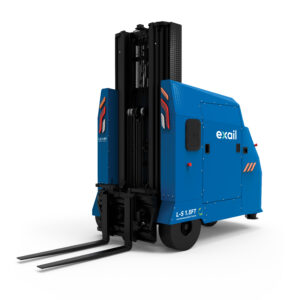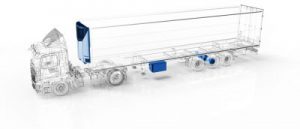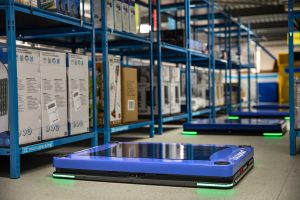
The autonomous GESSbot Gb 350 from Gessmann sets new standards in intralogistics by optimising… Read more »

The autonomous GESSbot Gb 350 from Gessmann sets new standards in intralogistics by optimising… Read more »

Inceptio Technology, developer of autonomous driving technologies for heavy-duty trucks, announced that heavy-duty trucks… Read more »

RightHand Robotics, a provider of data-driven, autonomous robotic picking solutions for order fulfillment, announces… Read more »

Intralogistics specialist Linde Material Handling and the Aschaffenburg University of Applied Sciences (UAS) presented… Read more »

Stock-taking in a warehouse is a time-consuming, manual process. Until now. David Priestman visited… Read more »

UPS and Aurrigo have announced a collaborative project to deploy Auto-Cargo, an autonomous electric… Read more »

Irish materials handling manufacturer Combilift has launched its first autonomous vehicle at the annual… Read more »

Inceptio Technology, one of China’s leading developer of autonomous driving technologies for heavy-duty trucks,… Read more »

Inceptio Technology, a Chinese developer of autonomous driving technologies for heavy-duty trucks, announced that… Read more »

Clevon, a global autonomous delivery innovator, and Lithuania’s leading grocery chain IKI are bringing… Read more »

Port of Felixstowe, part of the Hutchison Ports’ network, and Shanghai Westwell Technology Co.… Read more »

Exail, a leading high-tech industrial group specializing in cutting-edge robotics technologies, introduces its new… Read more »

OTTO Motors, a provider of autonomous mobile robots (AMRs), today unveiled its newest AMR,… Read more »

Leading London-based robotics and data intelligence company Dexory today announced the launch of their… Read more »

A.P. Moller – Maersk the integrated logistics company operating in 130 countries, has signed… Read more »

Hutchison Ports Port of Felixstowe is believed to be the first port in Europe… Read more »

Gideon, the robotics and AI solutions company, has launched Casey, an autonomous case picking… Read more »

DB Schenker, one of the world’s leading logistics providers, has revealed plans to operate… Read more »

Gideon, the robotics and AI solutions company, has announced a pioneering new solution –… Read more »

Due to the industry standard 4.0, digitalisation, automation and networking of systems and facilities… Read more »

The vision of autonomously driving transport vehicles in production halls or warehouses is to… Read more »

Outrider, a pioneer in autonomous yard operations for logistics hubs, has released fully autonomous… Read more »

DHL Supply Chain has introduced its largest-ever single implementation of autonomous forklifts to date,… Read more »

Estonia-based technology company Cleveron‘s unmanned autonomous vehicle took on the city of Eindhoven, the… Read more »

ELOKON has invested in the Munich-based start-up Filics, which has developed an innovative autonomous… Read more »

Musashi AI, a group company of Japanese Musashi Seimitsu Industry Co., Ltd., has successfully… Read more »

RAWview Drone Systems Ltd, a UK-based drone automation specialist has announced a new partnership… Read more »

Starship Technologies, a leading provider of autonomous delivery services, has announced that its delivery… Read more »

New mobile refrigerated containers with autonomous operation has been launched by Thermo King®, a… Read more »

Stefan Spendrup of SOTI looks at the effects autonomous driving will have on the… Read more »

Carrier Transicold has reaffirmed its commitment to reducing emissions, improving sustainability and increasing efficiency… Read more »

Nilfisk, a leading global provider of professional cleaning solutions and services, announces the launch… Read more »

The eQart® concept, launched in the fourth quarter 2019, is a customizable, smart, and… Read more »

UPS has begun testing the suitability and durability of Gaussin electric vehicles, which also… Read more »

Montapacking, one of the fastest growing e-commerce companies in the Netherlands, chose to automate… Read more »

UK-based autonomous vehicle specialist Aurrigo has developed a new way of transporting luggage around… Read more »

The German government has given PSI Logistics the lead in a national autonomous driving… Read more »

Linde Material Handling is expanding its portfolio of robotic solutions with the addition of… Read more »

Honeywell’s new Transportation Attitude Reference Sensor (TARS) is a packaged sensor array that enables… Read more »

Warehouse equipment manufacturer and solution provider Linde Material Handling has added a new, state-of-the-art… Read more »

Norwegian e-Navigation technology specialist NAVTOR is to spend the next three years helping the… Read more »

Volvo Trucks says it is now taking yet another important step in the development… Read more »

More than 33% of transport industry professionals do not believe autonomous vehicles will work,… Read more »

Linde Material Handling will be launching two new models from its innovative Linde-MATIC robotic… Read more »

Despite frequent discussions about AI’s potential impact on jobs, the majority of logistics workers… Read more »

In the UK, an alarming £250 million is estimated to be lost annually to… Read more »

Zetes, a leading specialist in supply chain execution solutions has invested in Robotize, a… Read more »